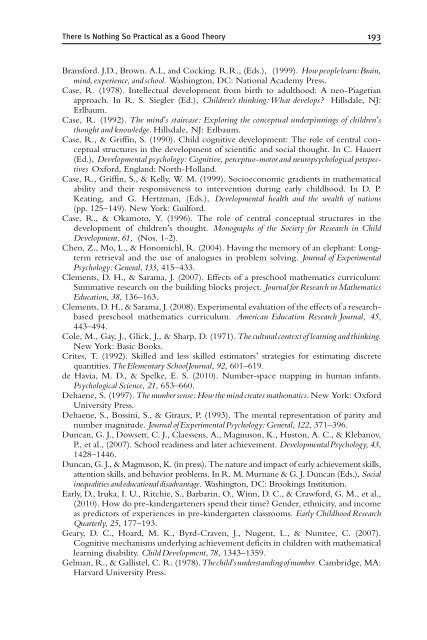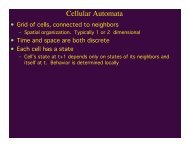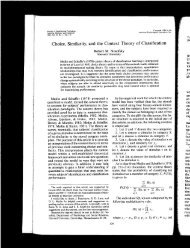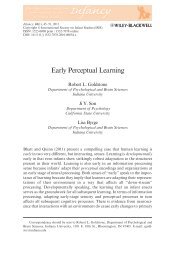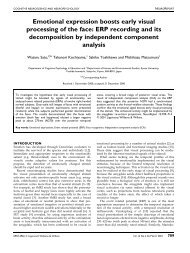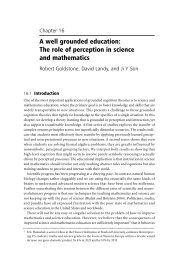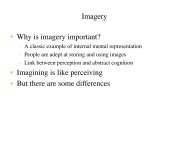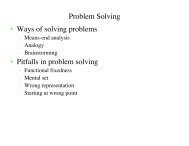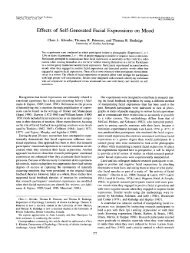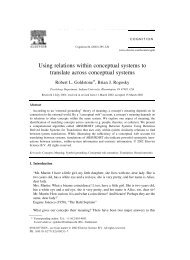There Is Nothing So Practical as a Good Theory 193Bransford. J.D., Brown. A.L, <strong>and</strong> Cocking. R.R., (Eds.), (1999). Howpeoplelearn:Brain,mind, experience, <strong>and</strong>school. Washington, DC: National Academy Press.Case, R. (1978). Intellectual development from birth to adulthood: A neo-Piagetianapproach. In R. S. Siegler (Ed.), Children’s thinking: What develops? Hillsdale, NJ:Erlbaum.Case, R. (1992). The mind’s staircase: Exploring <strong>the</strong> conceptual underpinnings <strong>of</strong> children’sthought <strong>and</strong> knowledge. Hillsdale, NJ: Erlbaum.Case, R., & Griffin, S. (1990). Child cognitive development: The role <strong>of</strong> central conceptualstructures in <strong>the</strong> development <strong>of</strong> scientific <strong>and</strong> social thought. In C. Hauert(Ed.), Developmental <strong>psychology</strong>: Cognitive, perceptuo-motor <strong>and</strong> neuropsychological perspectivesOxford, Engl<strong>and</strong>: North-Holl<strong>and</strong>.Case, R., Griffin, S., & Kelly, W. M. (1999). Socioeconomic gradients in ma<strong>the</strong>maticalability <strong>and</strong> <strong>the</strong>ir responsiveness to intervention during early childhood. In D. P.Keating, <strong>and</strong> G. Hertzman, (Eds.), Developmental health <strong>and</strong> <strong>the</strong> wealth <strong>of</strong> nations(pp. 125–149). New York: Guilford.Case, R., & Okamoto, Y. (1996). The role <strong>of</strong> central conceptual structures in <strong>the</strong>development <strong>of</strong> children’s thought. Monographs <strong>of</strong> <strong>the</strong> Society for Research in ChildDevelopment, 61, (Nos. 1-2).Chen, Z., Mo, L., & Honomichl, R. (2004). Having <strong>the</strong> memory <strong>of</strong> an elephant: Longtermretrieval <strong>and</strong> <strong>the</strong> use <strong>of</strong> analogues in problem solving. Journal <strong>of</strong> ExperimentalPsychology:General, 133, 415–433.Clements, D. H., & Sarama, J. (2007). Effects <strong>of</strong> a preschool ma<strong>the</strong>matics curriculum:Summative research on <strong>the</strong> building blocks project. Journal for Research in Ma<strong>the</strong>maticsEducation, 38, 136–163.Clements, D. H., & Sarama, J. (2008). Experimental evaluation <strong>of</strong> <strong>the</strong> effects <strong>of</strong> a researchbasedpreschool ma<strong>the</strong>matics curriculum. American Education Research Journal, 45,443–494.Cole, M., Gay, J., Glick, J., & Sharp, D. (1971).The cultural context <strong>of</strong> <strong>learning</strong><strong>and</strong> thinking.New York: Basic Books.Crites, T. (1992). Skilled <strong>and</strong> less skilled estimators’ strategies for estimating discretequantities.The ElementarySchoolJournal, 92, 601–619.de Havia, M. D., & Spelke, E. S. (2010). Number-space mapping in human infants.PsychologicalScience, 21, 653–660.Dehaene, S. (1997).The numbersense: How<strong>the</strong> mind creates ma<strong>the</strong>matics. New York: OxfordUniversity Press.Dehaene, S., Bossini, S., & Giraux, P. (1993). The mental representation <strong>of</strong> parity <strong>and</strong>number magnitude. Journal <strong>of</strong>ExperimentalPsychology: General, 122, 371–396.Duncan, G. J., Dowsett, C. J., Claessens, A., Magnuson, K., Huston, A. C., & Klebanov,P., et al., (2007). School readiness <strong>and</strong> later achievement. DevelopmentalPsychology, 43,1428–1446.Duncan, G. J., & Magnuson, K. (in press). The nature <strong>and</strong> impact <strong>of</strong> early achievement skills,attention skills, <strong>and</strong> behavior problems. In R. M. Murnane & G. J. Duncan (Eds.), Socialinequalities<strong>and</strong> educationaldisadvantage. Washington, DC: Brookings Institution.Early, D., Iruka, I. U., Ritchie, S., Barbarin, O., Winn, D. C., & Crawford, G. M., et al.,(2010). How do pre-kindergarteners spend <strong>the</strong>ir time? Gender, ethnicity, <strong>and</strong> incomeas predictors <strong>of</strong> experiences in pre-kindergarten classrooms. Early Childhood ResearchQuarterly, 25, 177–193.Geary, D. C., Hoard, M. K., Byrd-Craven, J., Nugent, L., & Numtee, C. (2007).Cognitive mechanisms underlying achievement deficits in children with ma<strong>the</strong>matical<strong>learning</strong> disability. ChildDevelopment, 78, 1343–1359.Gelman, R., & Gallistel, C. R. (1978).Thechild’sunderst<strong>and</strong>ing<strong>of</strong>number. Cambridge, MA:Harvard University Press.
194 Robert S. Siegler et al.Ginsberg, H. P., & Russell, R. L. (1981). Social class <strong>and</strong> racial influences on earlyma<strong>the</strong>matical thinking. Monographs<strong>of</strong> <strong>the</strong> Societyfor Researchin ChildDevelopment, 46(6)Serial No. 69.Griffin, S. (2003). Number Worlds: A research-based ma<strong>the</strong>matics program for youngchildren. In D. H. Clements, <strong>and</strong> J. Sarama, (Eds.), Engagingyoungchildreninma<strong>the</strong>matics:St<strong>and</strong>ards for early childhood ma<strong>the</strong>matics education (pp. 325–342). Mahwah, NJ:Lawrence Erlbaum Associates.Griffin, S. (2007). Early intervention for children at risk <strong>of</strong> developing ma<strong>the</strong>matical<strong>learning</strong> difficulties. In D. B. Berch, <strong>and</strong> M. M. Mazzocco, (Eds.),Whyis math sohardfor some children? The nature <strong>and</strong> origins <strong>of</strong> ma<strong>the</strong>matical <strong>learning</strong> di⁄culties <strong>and</strong> disabilities(pp. 373–396). Baltimore, MD: Brookes Publishing.Griffin, S., & Case, R. (1996). Evaluating <strong>the</strong> breadth <strong>and</strong> depth <strong>of</strong> training effects whencentral conceptual structures are taught. Society for Research in Child DevelopmentMonographs, 59, 90–113.Griffin, S., & Case, R. (1997). Re-thinking <strong>the</strong> primary school math curriculum: Anapproach based on cognitive science. IssuesinEducation, 3, 1–49.Griffin, S., Case, R., & Siegler, R. S. (1994). Rightstart: Providing <strong>the</strong> central conceptualprerequisites for first formal <strong>learning</strong> <strong>of</strong> arithmetic to students at risk for school failure.In K. McGilly (Ed.), Classroom lessons: Integrating cognitive <strong>the</strong>ory <strong>and</strong> classroom practice(pp. 25–49). Cambridge, MA: MIT Press.Hanich, L. B., Jordan, N. C., Kaplan, D., & Dick, J. (2001). Performance across differentareas <strong>of</strong> ma<strong>the</strong>matical cognition in children with <strong>learning</strong> difficulties. Journal <strong>of</strong>Educational Psychology, 93, 615–626.Holloway, S. D., Rambaud, M. F., Fuller, B., & Eggers-Pierola, C. (1995). What is‘‘appropriate practice’’ at home <strong>and</strong> in child care?: Low-income mo<strong>the</strong>r’s views onpreparing <strong>the</strong>ir children for school. EarlyChildhood ResearchQuarterly, 10, 451–473.Holyoak, K. J., & Mah, W. A. (1982). Cognitive reference points in judgments <strong>of</strong> symbolicmagnitude. Cognitive Psychology, 14, 328–352.Hubbard, E. M., Piazza, M., Pinel, P., & Dehaene, S. (2005). Interactions betweennumber <strong>and</strong> space in parietal cortex. Nature Reviews Neuroscience, 6, 435–448.Hughes, M. (1981). Can preschool children add <strong>and</strong> subtract? Educational Psychology, 1,207–219.Jordan, K. E., Su<strong>and</strong>a, S. H., & Brannon, E. M. (2008). Intersensory redundancy acceleratespreverbal numerical competence. Cognition, 108, 210–221.Jordan, N. C., Kaplan, D., Olah, L. N., & Locuniak, M. N. (2006). Number sense growthin kindergarten: a longitudinal investigation <strong>of</strong> children at risk for ma<strong>the</strong>matics difficulties.ChildDevelopment, 77, 153–175.Jordan, N. C., Kaplan, D., Ramineni, C., & Locuniak, M. N. (2009). Early math matters:Kindergarten number competence <strong>and</strong> later ma<strong>the</strong>matics outcomes. DevelopmentalPsychology, 45, 850–867.Klein, A., Starkey, P., Clements, D. H., Sarama, J., & Iyer, R. (2008). Effects <strong>of</strong> a prekindergartenma<strong>the</strong>matics intervention: A r<strong>and</strong>omized experiment. Journal<strong>of</strong>ResearchonEducationalE¡ectiveness, 1, 155–178.Kliban<strong>of</strong>f, R. S., Levine, S. C., Huttenlocher, J., Vasilyeva, M., & Hedges, L. V. (2006).Preschool children’s ma<strong>the</strong>matical knowledge: The effect <strong>of</strong> teacher ‘‘math talk.’’.DevelopmentalPsychology, 42, 59–69.Laski, E. V. (2008). Internal <strong>and</strong> external in£uences on <strong>learning</strong>: A microgenetic analysis <strong>of</strong> <strong>the</strong>acquisition <strong>of</strong> numerical knowledge from board games (Unpublished doctoral dissertation).Pittsburgh, PA: Carnegie Mellon University.Laski, E. V., & Siegler, R. S. (2007). Is 27 a big number? Correlational <strong>and</strong> causalconnections among numerical categorization, number line estimation, <strong>and</strong> numericalmagnitude comparison. ChildDevelopment, 76, 1723–1743.
- Page 3 and 4:
Series EditorBRIAN H. ROSSBeckman I
- Page 5 and 6:
Academic Press is an imprint of Els
- Page 7 and 8:
viContents3. Science of Multimedia
- Page 9 and 10:
This Page Intentionally Left Blank
- Page 11 and 12:
xContributorsHenry L. Roediger, III
- Page 13 and 14:
xiiPrefaceand there has been much e
- Page 15 and 16:
xivPrefaceInterventions for improvi
- Page 17 and 18:
2 Henry L. Roediger et al.delayed t
- Page 19 and 20:
4 Henry L. Roediger et al.an indire
- Page 21 and 22:
6 Henry L. Roediger et al.[(Figure_
- Page 23 and 24:
8 Henry L. Roediger et al.[(Figure_
- Page 25 and 26:
10 Henry L. Roediger et al.seems so
- Page 27 and 28:
12 Henry L. Roediger et al.interpre
- Page 29 and 30:
14 Henry L. Roediger et al.Table 2
- Page 31 and 32:
16 Henry L. Roediger et al.improved
- Page 33 and 34:
18 Henry L. Roediger et al.this mat
- Page 35 and 36:
20 Henry L. Roediger et al.length o
- Page 37 and 38:
22 Henry L. Roediger et al.9. BENEF
- Page 39 and 40:
24 Henry L. Roediger et al.subjects
- Page 41 and 42:
26 Henry L. Roediger et al.feedback
- Page 43 and 44:
28 Henry L. Roediger et al.supporti
- Page 45 and 46:
30 Henry L. Roediger et al.of some
- Page 47 and 48:
32 Henry L. Roediger et al.Benefit
- Page 49 and 50:
34 Henry L. Roediger et al.Hasher,
- Page 51 and 52:
36 Henry L. Roediger et al.Son, L.
- Page 53 and 54:
38 John Sweller1. INTRODUCTIONCogni
- Page 55 and 56:
40 John Sweller‘‘baby-talk.’
- Page 57 and 58:
42 John Swellerof cognitive or meta
- Page 59 and 60:
44 John SwellerTable 1Natural Infor
- Page 61 and 62:
46 John Swellerconfigurations. A ch
- Page 63 and 64:
48 John Swellerreproduction results
- Page 65 and 66:
50 John Swellerto mutation, without
- Page 67 and 68:
52 John Swellerusing a complex or,
- Page 69 and 70:
54 John SwellerThe human cognitive
- Page 71 and 72:
56 John Swellerepigenetic system ha
- Page 73 and 74:
58 John SwellerWe can determine lev
- Page 75 and 76:
60 John Swellerthan memorizing the
- Page 77 and 78:
62 John SwellerTable 2EffectVariabi
- Page 79 and 80:
64 John Swelleroccurs when students
- Page 81 and 82:
66 John Sweller3.3.3. The Split-Att
- Page 83 and 84:
68 John Swellermerely restates the
- Page 85 and 86:
70 John SwellerThe expertise revers
- Page 87 and 88:
72 John Swellerobtained a reverse m
- Page 89 and 90:
74 John Swelleractivities that othe
- Page 91 and 92:
76 John SwellerRenkl, A. (2005). Th
- Page 93 and 94:
78 Richard E. Mayercognitive theory
- Page 95 and 96:
80 Richard E. Mayerpictures beginni
- Page 97 and 98:
82 Richard E. MayerThe dualchannelp
- Page 99 and 100:
84 Richard E. Mayerlearner selects
- Page 101 and 102:
86 Richard E. MayerRosenthal, Rosno
- Page 103 and 104:
88 Richard E. MayerGenerative proce
- Page 105 and 106:
90 Richard E. Mayer4.2. Evidence-ba
- Page 107 and 108:
92 Richard E. Mayersituation could
- Page 109 and 110:
94 Richard E. Mayer(Moreno & Mayer,
- Page 111 and 112:
96 Richard E. Mayer4.3.1. Segmentin
- Page 113 and 114:
98 Richard E. Mayerpresenting the w
- Page 115 and 116:
100 Richard E. MayerThe multimedia
- Page 117 and 118:
102 Richard E. Mayergame in industr
- Page 119 and 120:
104 Richard E. MayerClark, R. C., &
- Page 121 and 122:
106 Richard E. MayerMayer, R. E., &
- Page 123 and 124:
108 Richard E. MayerSweller, J. (19
- Page 125:
110 Timothy J. Nokes and Daniel M.
- Page 128 and 129:
Incorporating Motivation into a The
- Page 130 and 131:
Incorporating Motivation into a The
- Page 132 and 133:
Incorporating Motivation into a The
- Page 134 and 135:
Incorporating Motivation into a The
- Page 136 and 137:
Incorporating Motivation into a The
- Page 138 and 139:
Incorporating Motivation into a The
- Page 140 and 141:
Incorporating Motivation into a The
- Page 142 and 143:
Incorporating Motivation into a The
- Page 144 and 145:
Incorporating Motivation into a The
- Page 146 and 147:
Incorporating Motivation into a The
- Page 148 and 149:
Incorporating Motivation into a The
- Page 150 and 151:
Incorporating Motivation into a The
- Page 152 and 153:
CHAPTERFIVEOn the Interplay of Emot
- Page 154 and 155:
Implications for Enhancing Academic
- Page 156 and 157:
Implications for Enhancing Academic
- Page 158 and 159: Implications for Enhancing Academic
- Page 160 and 161: Implications for Enhancing Academic
- Page 162 and 163: Implications for Enhancing Academic
- Page 164 and 165: Implications for Enhancing Academic
- Page 166 and 167: Implications for Enhancing Academic
- Page 168 and 169: Implications for Enhancing Academic
- Page 170 and 171: Implications for Enhancing Academic
- Page 172 and 173: Implications for Enhancing Academic
- Page 174 and 175: Implications for Enhancing Academic
- Page 176 and 177: Implications for Enhancing Academic
- Page 178 and 179: Implications for Enhancing Academic
- Page 180 and 181: Implications for Enhancing Academic
- Page 182 and 183: Implications for Enhancing Academic
- Page 184 and 185: Implications for Enhancing Academic
- Page 186 and 187: CHAPTERSIXThere Is Nothing So Pract
- Page 188 and 189: There Is Nothing So Practical as a
- Page 190 and 191: There Is Nothing So Practical as a
- Page 192 and 193: There Is Nothing So Practical as a
- Page 194 and 195: There Is Nothing So Practical as a
- Page 196 and 197: There Is Nothing So Practical as a
- Page 198 and 199: There Is Nothing So Practical as a
- Page 200 and 201: There Is Nothing So Practical as a
- Page 202 and 203: There Is Nothing So Practical as a
- Page 204 and 205: There Is Nothing So Practical as a
- Page 206 and 207: There Is Nothing So Practical as a
- Page 210 and 211: There Is Nothing So Practical as a
- Page 212 and 213: There Is Nothing So Practical as a
- Page 214 and 215: CHAPTERSEVENThe Power of Comparison
- Page 216 and 217: The Power of Comparison in Learning
- Page 218 and 219: The Power of Comparison in Learning
- Page 220 and 221: The Power of Comparison in Learning
- Page 222 and 223: The Power of Comparison in Learning
- Page 224 and 225: The Power of Comparison in Learning
- Page 226 and 227: The Power of Comparison in Learning
- Page 228 and 229: The Power of Comparison in Learning
- Page 230 and 231: The Power of Comparison in Learning
- Page 232 and 233: The Power of Comparison in Learning
- Page 234 and 235: The Power of Comparison in Learning
- Page 236 and 237: The Power of Comparison in Learning
- Page 238 and 239: The Power of Comparison in Learning
- Page 240 and 241: The Power of Comparison in Learning
- Page 242 and 243: CHAPTEREIGHTThe Ubiquitous Patterns
- Page 244 and 245: The Ubiquitous Patterns of Incorrec
- Page 246 and 247: The Ubiquitous Patterns of Incorrec
- Page 248 and 249: The Ubiquitous Patterns of Incorrec
- Page 250 and 251: The Ubiquitous Patterns of Incorrec
- Page 252 and 253: The Ubiquitous Patterns of Incorrec
- Page 254 and 255: The Ubiquitous Patterns of Incorrec
- Page 256 and 257: The Ubiquitous Patterns of Incorrec
- Page 258 and 259:
The Ubiquitous Patterns of Incorrec
- Page 260 and 261:
The Ubiquitous Patterns of Incorrec
- Page 262 and 263:
The Ubiquitous Patterns of Incorrec
- Page 264 and 265:
The Ubiquitous Patterns of Incorrec
- Page 266 and 267:
The Ubiquitous Patterns of Incorrec
- Page 268 and 269:
The Ubiquitous Patterns of Incorrec
- Page 270 and 271:
The Ubiquitous Patterns of Incorrec
- Page 272 and 273:
The Ubiquitous Patterns of Incorrec
- Page 274 and 275:
The Ubiquitous Patterns of Incorrec
- Page 276 and 277:
The Ubiquitous Patterns of Incorrec
- Page 278 and 279:
The Ubiquitous Patterns of Incorrec
- Page 280 and 281:
The Ubiquitous Patterns of Incorrec
- Page 282 and 283:
The Ubiquitous Patterns of Incorrec
- Page 284 and 285:
CHAPTERNINEConceptual Problem Solvi
- Page 286 and 287:
Conceptual Problem Solving in Physi
- Page 288 and 289:
Conceptual Problem Solving in Physi
- Page 290 and 291:
Conceptual Problem Solving in Physi
- Page 292 and 293:
Conceptual Problem Solving in Physi
- Page 294 and 295:
Conceptual Problem Solving in Physi
- Page 296 and 297:
Conceptual Problem Solving in Physi
- Page 298 and 299:
Conceptual Problem Solving in Physi
- Page 300 and 301:
Conceptual Problem Solving in Physi
- Page 302 and 303:
Conceptual Problem Solving in Physi
- Page 304 and 305:
Conceptual Problem Solving in Physi
- Page 306 and 307:
Conceptual Problem Solving in Physi
- Page 308 and 309:
Conceptual Problem Solving in Physi
- Page 310 and 311:
Conceptual Problem Solving in Physi
- Page 312 and 313:
Conceptual Problem Solving in Physi
- Page 314 and 315:
IndexAAcademic performancedrive the
- Page 316 and 317:
Index 301Correct method comparison,
- Page 318 and 319:
Index 303LLabor in vain, 28Language
- Page 320 and 321:
Index 305OOntological categories of
- Page 322 and 323:
Index 307WWeb-delivered multimedia
- Page 324 and 325:
CONTENTS OF RECENT VOLUMESVolume 40
- Page 326 and 327:
Contents of Recent Volumes 311Under
- Page 328 and 329:
Contents of Recent Volumes 313Volum


